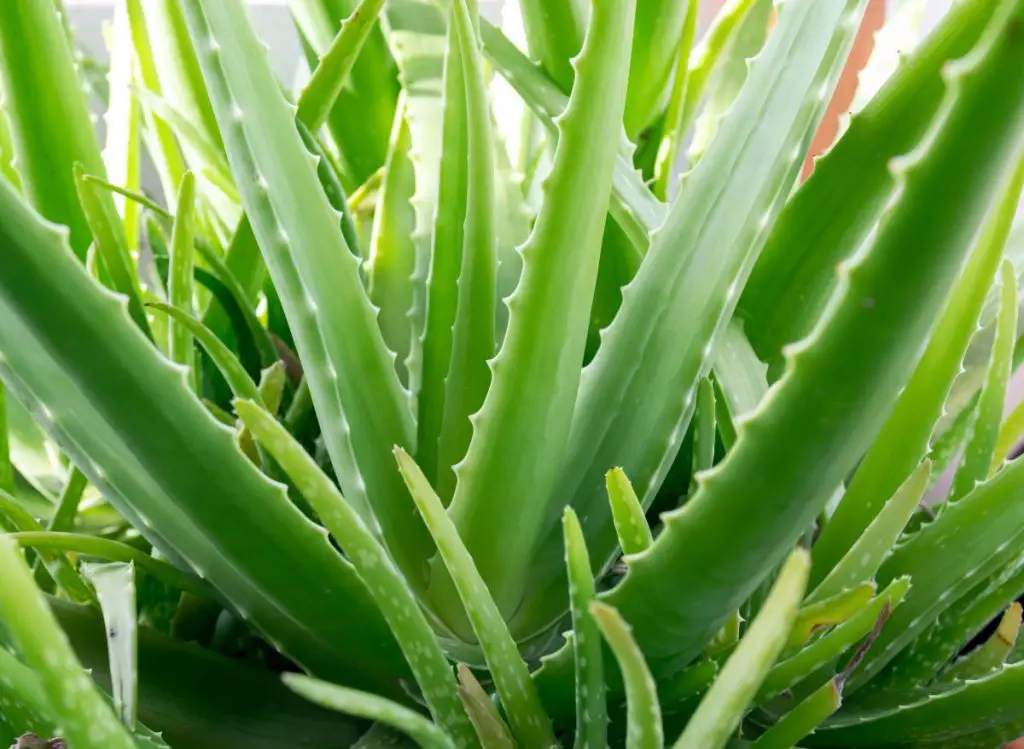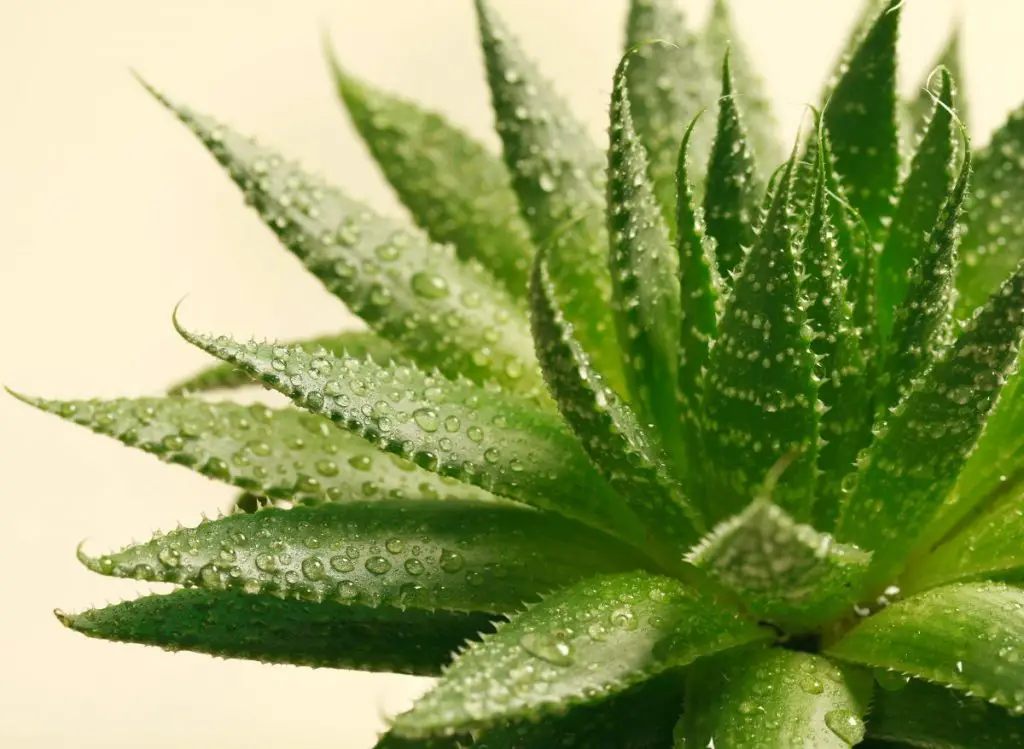
Also known as the Burn Plant, the aloe vera plant is often kept growing in the home in case someone in the family gets a minor burn or other minor skin irritation. One leaf of the plant is removed from the plant, and the interior gel is extracted and placed on the burn or irritation to provide instant cooling and soothing and to promote healing.
You might wonder why is my aloe vera plant drooping. The main reasons for aloe plants with drooping leaves are generally because the aloe is in too much shade, overwatering, underwatering and insufficient lighting with some direct sunlight.
Aloe vera is an ancient plant that has been cultivated for thousands of years. It’s highly prized for the multitude of health benefits it provides and is used in everything from cosmetics to treatments for digestive issues.
Aloe vera is easy to grow, but if the plant’s needs are not met, the leaves will begin to droop instead of standing erect.
If your aloe vera plant is not looking as perky as it once did, read on to discover why your aloe vera plant is drooping.
You might also enjoy reading: Why Do Succulents Change Color (Here are the reasons!)
Here’s Why Is Your Aloe Vera Plant Drooping And How to Fix Them:
If your aloe vera plant is drooping, here are the reasons and how to revive your plant.
1- Too Much Water
Giving the plant too much water is the main cause of drooping leaves. The plant is native to hot, dry environments and does not respond well to being given too much water.
In its native environment, the plant absorbs water from the sparse rainfall and stores moisture in its leaves. This is why the plant has thick, fleshy leaves. If you give the plant too much water, the leaves are not able to absorb all of it, and this creates stress for the plant.
It will try to absorb the excess water, but it can’t, and the leaves begin to split open and droop as a result.
How To Fix Aloe Vera Overwatering:
- To fix the problem, stop watering until the soil dries out.
- Then resume watering only when the top 2 inches (5.08 cm) of soil are dry to the touch.
- If you want to revive an overwatered aloe plant, trim back any roots with pruners.
- Remove leaves turning brown or yellow, change the potting soil with a gritty, well-draining potting mix and wait until the growing soil is parched before watering again.
2- Not Enough Water
If your aloe vera plant is not getting enough water, it will use the stored water in its leaves to survive. The leaves will become thin, soft, and droopy since they are no longer filled with water.
How To Fix Aloe Vera Underwatering:
- To get those leaves standing erect again, water the plant.
- Apply water at the soil level and be careful not to get the leaves wet.
- To revive an underwatered aloe plant, put the aloe pot in a container full of water for about 10 minutes, making sure the root ball is submerged to evenly moisten the soil.
So, how do you know whether your aloe vera is overwatered or underwatered? Looking at the leaves is the most effective way to tell if your aloe vera is overwatered or underwatered. Overwatered aloe leaves generally turn brown and yellow with a mushy and soft texture. In contrast, underwatered aloe leaves tend to become thinner and shrink in size before they turn brown.
3- Lighting Problems
All plants need a certain amount of light each day for photosynthesis; this is how they manufacture their food. Green plants utilize sunlight to synthesize and produce foods from carbon dioxide and water.
As a native desert plant, aloe vera needs plenty of bright light to produce food. Without the needed light, the plant becomes undernourished and begins to weaken, and the leaves will droop.
Generally, aloe vera plants thrive in both full sun with about six or more hours of direct sunlight daily and partial shade receiving direct sunlight only part of the day, about 2 to 6 hours (Source: North Carolina State University)
How To Fix Aloe Vera Lighting Problems:
- Place your Aloe vera close to a sunny window.
- During cooler and darker winter months, you may need to move your aloe vera to a brighter spot to get the light it needs.
- Aloe vera plants need at least 3 hours of bright, indirect sunlight each day for photosynthesis.
- Move your plant to a brighter location, and the leaves will stand tall again in a few days.
See also: Why Is Your ZZ Plant Leaves Turning Brown? (6 Reasons and tips to fix them)
4- Diseases
Aloe vera plants have 3 common diseases that can cause the plants to droop:
- Aloe rust is a fungal disease caused by cool temperatures and high humidity. The plant will develop yellow spots on the leaves that turn dark brown.
- To stop the disease, prune off affected leaves and move your plant to a warmer, drier location.
- Basal stem rot is caused by too much moisture and cool temperatures. It’s a fungal disease that will cause the base of the plant to turn reddish-brown and eventually black.
- Basal stem rot is fatal to the plant. Take cutting off the healthiest leaf to propagate a new plant and discard the diseased plant.
- Bacterial soft rot is caused by too much moisture and warm temperatures. This combination creates the perfect environment for bacteria to grow. A plant infected with this disease will develop droopy leaves that turn dark and watery bulges will develop along the leaves.
- Bacterial soft rot is fatal, and none of the plants is salvageable.
5- Cold Temperatures
If the plant is exposed to temperatures that are below 55F, the plant won’t be happy, and the leaves will begin to droop. Like in its natural habitat, Aloe vera loves to be warm and dry.
How To Fix This Issue:
- Place the plant in a warmer location that is away from exterior doors and air conditioning vents. Don’t let the leaves touch the window glass during the winter.
- If you live in a climate that has a mild winter and leaves your potted aloe vera plant outdoors, make sure it is under a roof or overhang so it will be protected from frost. Even a light frost will kill the plant.

6- Pest Attacks
Aloe vera is rarely attacked by pests, but it does happen occasionally. Aphids, mealybugs, and mites sometimes attack the plant. If pests are the problem, only the infested leaves will droop, not all of them.
How To Prevent Aloe Vera Pest Attacks:
- Inspect the plants for signs of pests if you notice just one or two leaves drooping. White spots may develop on the leaves, or the plant may develop odd-looking growths.
- To remove and save the pests, hand-pick all visible pests off the plants and drown them in a water container.
- Dampen a soft, clean cloth with rubbing alcohol and wipe down each leaf to remove pest eggs.
- Spray the plant with insecticidal soap.
- Prune off any damaged leaves.
See also: ZZ Plant Leaves Turning Yellow (5 Reasons And how to fix them)
7- Transplant Shock
A container-grown aloe vera plant will need to be re-potted every few years. They don’t like that and may go into shock a develop droopy leaves.
The roots being exposed to air troubles the plant the most, so steps need to be taken to minimize the time that air hits the plant roots during transplanting.
How To Fix Aloe Vera Transplant Shock:
- Get everything ready before removing the plant from its container.
- Have the new container half full of soil with more soil close by to finish filling up the container.
- Wear soft cotton gloves and be very gentle when handling the plant.
- Have a glass of lukewarm water near so you can immediately water the transplanted aloe vera. This will help the soil settle around the roots and limit their exposure to air.
- Do not water again for at least one week.
8- The Plant Is Too Big For The Pot
An aloe plant that is too big for the pot will become top-heavy and fall over. It’s not exactly why your aloe vera plant is drooping, but when the plant falls over, it can damage the leaves, pups (new aloe vera sprouts), or other nearby plants.
How To Fix This Issue:
- The plant must be repotted before it becomes root bound and can no longer uptake water or nutrients.
- Select a pot that is 1-2 sizes larger than the current pot for the main aloe plant. If there are pups, use a different pot for each pup.
- Fill 2/3‘s of the pot with well-draining potting soil.
- Prune off any damaged leaves from the plant before repotting.
I suggest you work quickly so the roots won’t be exposed to the air for long. Air exposure will cause the leaves to droop after the plant has been transplanted.
See also: How Often To Fertilize ZZ Plant? (With the best fertilizers for ZZ plant)
Final Thoughts
Aloe vera is an evergreen succulent that is native to tropical and arid climates where it grows wild. All other climates have easily tamed the wild plant and used it as a houseplant for both beauty and medicinal purposes.
However, if your Aloe vera plant’s needs are not met, the leaves will start to droop instead of standing erect. Follow the tips outlined in this article to identify and fix Why is your aloe vera plant drooping.
What to read next:

